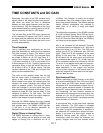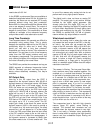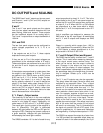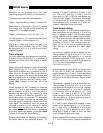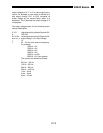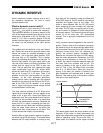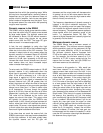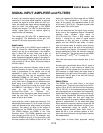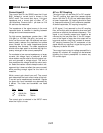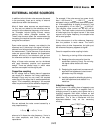
3-18
SR850 Basics
frequencies than within the operating range. While
this may be a nice specification, removing noise at
frequencies very far from the reference does not
require a lock-in amplifier. Lock-ins are used when
there is noise at frequencies near the signal. Thus,
the dynamic reserve for noise within the operating
range is more important.
Dynamic reserve in the SR850
The SR850, with its digital phase sensitive detec-
tors, does not suffer from DC output errors caused
by large noise signals. The dynamic reserve can
be increased to above 100 dB without measure-
ment error. Large noise signals do not cause
output errors from the PSD. The large DC gain
does not result in increased output drift.
In fact, the only drawback to using ultra high
dynamic reserves (>60 dB) is the increased output
noise due to the noise of the A/D converter. This
increase in output noise is only present when the
dynamic reserve is increased above 60 dB AND
above the minimum reserve. (If the minimum
reserve is 80 dB, then increasing to 90 dB may
increase the noise. As we'll discuss next, the mini-
mum reserve does not have increased output
noise no matter how large it is.)
To set a scale, the SR850's output noise at 100 dB
dynamic reserve is only measurable when the
signal input is grounded. Let's do a simple experi-
ment. If the lock-in reference is at 1 kHz and a
large signal is applied at 9.5 kHz, what will the
lock-in output be? If the signal is increased to the
dynamic reserve limit (100 dB greater than full
scale), the output will reflect the noise of the signal
at 1 kHz. The spectrum of any pure sine generator
always has a noise floor, i.e. there is some noise
at all frequencies. So even though the applied
signal is at 9.5 kHz, there will be noise at all other
frequencies, including the 1 kHz lock-in reference.
This noise will be detected by the lock-in and
appear as noise at the output. This output noise
will typically be greater than the SR850's own
output noise. In fact, virtually all signal sources will
have a noise floor which will dominate the lock-in
output noise. Of course, noise signals are general-
ly much noisier than pure sine generators and will
have much higher broadband noise floors.
If the noise does not reach the reserve limit, the
SR850's own output noise may become detectable
at ultra high reserves. In this case, simply lower
the dynamic reserve and the DC gain will
decrease and the output noise will decrease also.
In general, do not run with more reserve than nec-
essary. Certainly don't use ultra high reserve when
there is virtually no noise at all.
The frequency dependence of dynamic reserve is
inherent in the lock-in detection technique. The
SR850, by providing more low pass filter stages,
can increase the dynamic reserve close to the ref-
erence frequency. The specified reserve applies to
noise signals within the operating range of the
lock-in, i.e. frequencies below 100 kHz. The
reserve at higher frequencies is actually higher but
is generally not that useful.
Minimum dynamic reserve
The SR850 always has a minimum amount of
dynamic reserve. This minimum reserve changes
with the sensitivity (gain) of the instrument. At high
gains (full scale sensitivity of 50 µV and below),
the minimum dynamic reserve increases from
37 dB at the same rate as the sensitivity increas-
es. For example, the minimum reserve at 5 µV
sensitivity is 57 dB. In many analog lock-ins, the
reserve can be lower. Why can't the SR850 run
with lower reserve at this sensitivity?
The answer to this question is - Why would you
want lower reserve? In an analog lock-in, lower
reserve means less output error and drift. In the
SR850, more reserve does not increase the output
error or drift. More reserve can increase the output
noise though. However, if the analog signal gain
before the A/D converter is high enough, the
5 nV/√Hz noise of the signal input will be amplified
to a level greater than the input noise of the A/D
converter. At this point, the detected noise will
reflect the actual noise at the signal input and not
the A/D converter's noise. Increasing the analog
gain (decreasing the reserve) will not decrease the
output noise. Thus, there is no reason to decrease
the reserve. At a sensitivity of 5 µV, the analog
gain is sufficiently high so that A/D converter noise
is not a problem. Sensitivities below 5 µV do not
require any more gain since the signal to noise
ratio will not be improved (the front end noise dom-
inates). The SR850 does not increase the gain
below the 5 µV sensitivity, instead, the minimum
reserve increases. Of course, the input gain can
be decreased and the reserve increased, in which
case the A/D converter noise might be detected in
the absence of any signal input.




